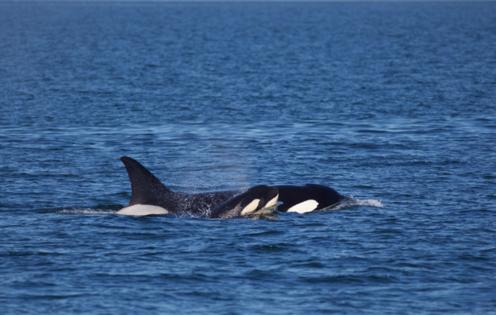Drones spot 'first evidence' of orcas making tools, study says
Published in Science & Technology News
Over the years, orcas have been seen partaking in some peculiar practices, from sinking sailboats to wearing salmon “hats.”
Now, the apex predators have been observed engaging in a “remarkable” new behavior: fashioning tools from underwater plants to massage one another.
The discovery — published Monday in Current Biology — constitutes the “first evidence” recorded of tool-making by marine mammals.
“We were amazed when we first noticed this,” Michael Weiss, the director of the Center for Whale Research, said in a University of Exeter news release.
Allokelping
Researchers from both institutions stumbled upon the previously unknown behavior while flying drones over the “southern resident” orcas in the Salish Sea, located between Washington and British Columbia.
“I was watching one of those really close-up videos when I saw something that looked like a brown stick between two whales that were in contact with each other,” Rachel John, an Exeter master’s student, said in the release.
Researchers realized this was not an isolated incident. Close analysis revealed it happened again and again — and involving the same steps each time.
Whales were seen biting off the tips of bull kelp stalks, placing them between themselves and another whale and then rolling the stalk between their two bodies over long periods — with the longest lasting 12 minutes.
This newfound behavior — dubbed “allokelping” — is distinct from “kelping,” a phenomenon previously observed in multiple whale species, wherein whales move kelp with their bodies, heads and fins.
Allokelping, by contrast, involves deliberately selecting, trimming and manipulating kelp with a partner — qualifying it as tool-making, previously thought to be the exclusive domain of land animals.
Researchers documented allokelping on eight separate days out of the 12-day study period, indicating it could be a very common behavior among southern resident killer whales.
Social bonding and good hygiene
It’s not exactly clear why the killer whales rub themselves with kelp stalks, but a few hypotheses were put forward.
One is that the behavior — seen among relatives and similar aged animals — plays an important part of the whales’ social lives.
“We know touch is really important,” Darren Croft, the executive director of the CWR, said in the release. “In primates – including humans – touch moderates stress and helps to build relationships. We know killer whales often make contact with other members of their group – touching with their bodies and fins – but using kelp like this might enhance this experience.”
Allokelping could also benefit orcas’ skin (some dermatologists have lauded its effects on human skin as well).
“Whales and dolphins have a variety of strategies to help them slough dead skin, and this may be yet another adaptation for this purpose,” Croft said.
Bull kelp, a type of algae, is also known to have anti-inflammatory and antibacterial properties.
Critical moment
The finding comes at a critical moment for southern resident killer whales as just 73 individuals remain, according to the CWR’s latest census, conducted in July.
The whales primarily feed on King salmon, also known as Chinook, a species that experienced significant declines due to climate change, over-fishing and habitat destruction.
The future of the whale population — which does not interbreed with others — looks “very bleak,” Weiss said.
“We’re not seeing the birth rate that’s required to sustain the population,” Weiss said. “Under the status quo, all of our projections indicate the population will continue to decline.”
_____
©2025 The Charlotte Observer. Visit at charlotteobserver.com. Distributed by Tribune Content Agency, LLC.







Comments